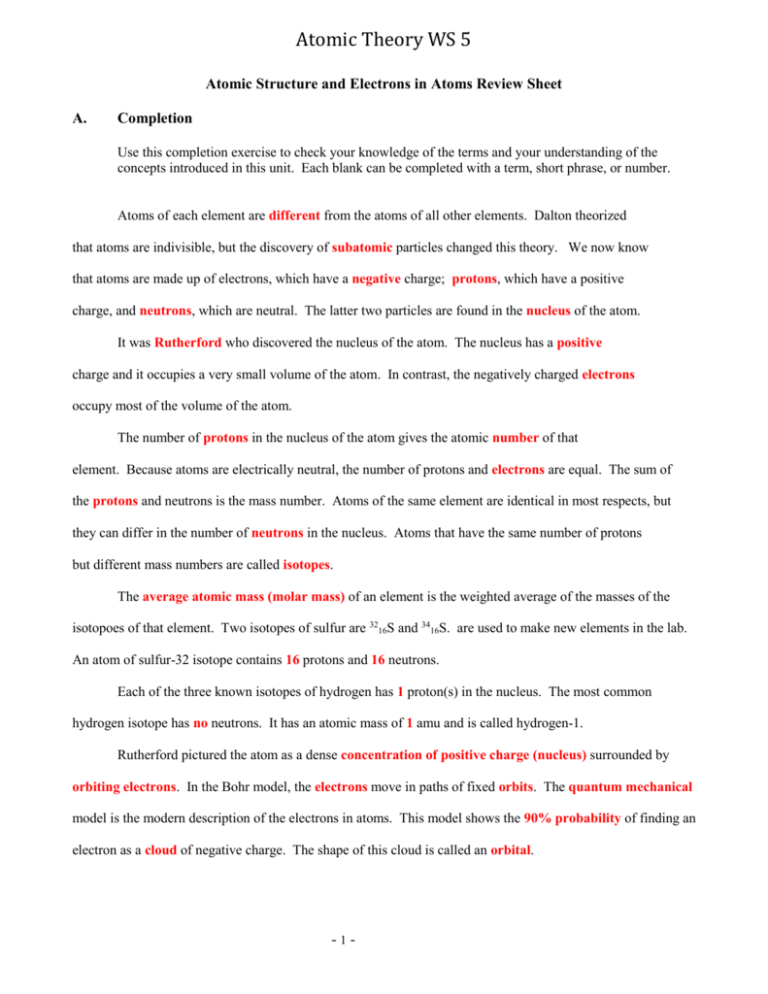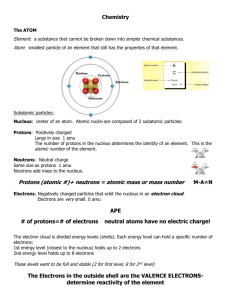Atomic Theory WS 5
advertisement

Atomic Theory WS 5 Atomic Structure and Electrons in Atoms Review Sheet A. Completion Use this completion exercise to check your knowledge of the terms and your understanding of the concepts introduced in this unit. Each blank can be completed with a term, short phrase, or number. Atoms of each element are different from the atoms of all other elements. Dalton theorized that atoms are indivisible, but the discovery of subatomic particles changed this theory. We now know that atoms are made up of electrons, which have a negative charge; protons, which have a positive charge, and neutrons, which are neutral. The latter two particles are found in the nucleus of the atom. It was Rutherford who discovered the nucleus of the atom. The nucleus has a positive charge and it occupies a very small volume of the atom. In contrast, the negatively charged electrons occupy most of the volume of the atom. The number of protons in the nucleus of the atom gives the atomic number of that element. Because atoms are electrically neutral, the number of protons and electrons are equal. The sum of the protons and neutrons is the mass number. Atoms of the same element are identical in most respects, but they can differ in the number of neutrons in the nucleus. Atoms that have the same number of protons but different mass numbers are called isotopes. The average atomic mass (molar mass) of an element is the weighted average of the masses of the isotopoes of that element. Two isotopes of sulfur are 3216S and 3416S. are used to make new elements in the lab. An atom of sulfur-32 isotope contains 16 protons and 16 neutrons. Each of the three known isotopes of hydrogen has 1 proton(s) in the nucleus. The most common hydrogen isotope has no neutrons. It has an atomic mass of 1 amu and is called hydrogen-1. Rutherford pictured the atom as a dense concentration of positive charge (nucleus) surrounded by orbiting electrons. In the Bohr model, the electrons move in paths of fixed orbits. The quantum mechanical model is the modern description of the electrons in atoms. This model shows the 90% probability of finding an electron as a cloud of negative charge. The shape of this cloud is called an orbital. -1- Atomic Theory WS 5 The ways in which electrons are arranged around the nuclei of atoms are called electron configurations. The Aufbau Principle tells us the sequence in which orbitals are filled. The Pauli Exclusion Principle states that a maximum of only 2 electrons can occupy each orbital, spinning in opposite directions. Hund’s rule states that the electrons pair up only after each orbital in a sublevel is occupied by 1 electron. Every element emits EMR (radiation) if it is heated by passing an electric discharge through its gas or vapor. Passing this emission through a prism gives unique line spectrum of the element. B. True-False Classify each of these statements as always true (AT); sometimes true (ST); or never true (NT). __NT___ 1. According to Dalton’s atomic theory, atoms are composed of protons, electrons, and neutrons. (single particle, like billiard ball) __AT___ 2. Atoms of elements are electrically neutral. __NT___ 3. The mass of an electron is equal to the mass of a neutron. (weighted average – includes protons + neutrons, isotopes) __AT___ 4. The charge on all protons is the same. __NT__ 5. The atomic number of an element is the sum of the protons and electrons in the atom. __NT___ 6. The atomic number of an element is the whole number that decreases as you read across each row of the periodic table from left to right. __ST___ 7. An atom of nitrogen has 7 protons and 7 neutrons. (isotopes have different number of neutrons) __ST___ 8. Relative masses are measured in amus. (or grams, when expressed as molar mass) __AT___ 9. The number of neutrons in the nucleus can be calculated by subtracting the atomic number from the mass number. __AT__ 10. Electrons must have a certain minimum amount of energy, called a quantum of energy, in order to move from one energy level to a higher energy level. __ST__ 11. Atomic orbitals are spherical in shape. (s orbitals only) __NT__ 12. The number of sublevels in an energy level is equal to the square of the principal quantum number of that energy level. __S/AT 13. The Aufbau diagram can be used to obtain electron configurations for atoms. (exceptions are in d and f blocks) -2- Atomic Theory WS 5 C. Problems Answer the following questions or solve the following problems in the space provided. Show your work. 1. Complete the following table: Element Symbol Atomic # Mass # # of protons # of electrons # of neutrons 6C 6 12 6 6 6 19K 19 40 19 19 21 2He 2 4 2 2 2 2+ 4 9 4 2 5 37N 7 15 7 10 8 Carbon-12 12 Potassium-40 40 Helium-4 4 Beryllium-9 ion 9 Nitrogen-15 ion 15 4Be 2. Given the relative abundance of the following naturally occurring isotopes of bromine, calculate the average atomic mass. Br-79 78.92 amu, 50.69% Br-81 80.92 amu, 49.31% 78.92 amu x 50.69% = 4000. amu % 80.92 amu, 49.31% = 3990. amu % 7990. amu% 100% = 79.90 amu 3. What is the color and frequency of EMR that has a wavelength of 4.7 x 10-5 cm? =c = 3.00 x 108 m = 0.64 x 1015 s-1 = 6.4 x 1014 s-1 4.7 x 10-7 m s = 4.7 x 10-5 cm (1 m) (109 nm) = 4.7 x 102 nm = 470 nm BLUE 102 cm 1m -7 = 4.7 x 10 m 4. Calculate the energy of a quantum of radiant energy whose frequency is 3.82 x 1012 s-1. (h = 6.626 x 10-34J x s) E = h = 3.82 x 1012 s-1 E = (6.626 x 10-34 J s)( 3.82 x 1012 s-1) = 25.3 x 10-22 J = 2.53 x 10-21 J -3- Atomic Theory WS 5 5. For each group of sublevels, circle the one that fills last as electrons are added. a. 3p 2p 1s 2s 3s b. 4p 3p 2p 4s 4d 5s c. 3d 4s 3p 3s 2s 6. Write the orbital diagram and complete electron configuration for the potassium atom. 19 e-‘s: 1s22s2sp63s23p64s1 1s 2s 2p 3s 3p 4s 7. What is the element with the electron configuration: 1s22s22p63s23p64s23d7 cobalt 8. Draw electron dot diagrams (Lewis structures) for: radon .. : Rn : .. beryllium . Be . sulfur .. .S: . nitrogen . :N. . iodine .. : I: . -4-







